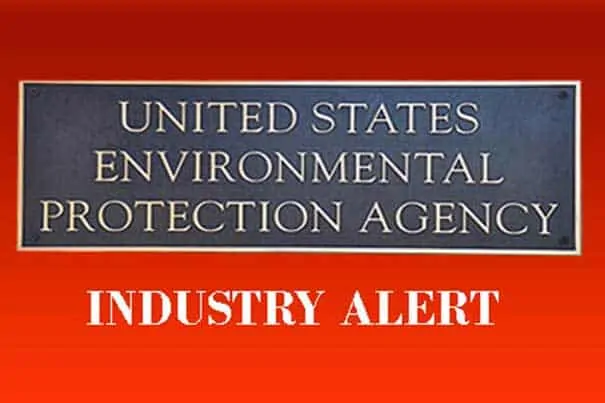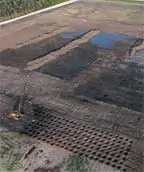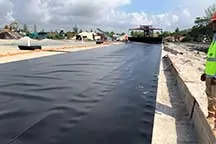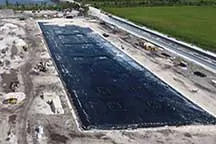


Stephanie Taylor’s outstanding work recently earned her the prestigious Air & Waste Management Association’s 2021 Young Professional Award. As an SCS Engineers Environmental Professional, Stephanie manages and supports numerous clients in the Midwest, providing valuable air compliance/permitting and groundwater compliance services. She is a respected colleague at SCS and frequently provides services to offices outside of her business unit as an air compliance/permitting specialist.
In her recent work, Stephanie provided air compliance/permit audit services to a private client completing a companywide multimedia audit. Her work took her to multiple industrial manufacturing plants nationwide. Her attention to detail is integral in identifying non-compliance and areas of improvement that her client implemented company-wide to improve operations and compliance with permit requirements.
Stephanie joined with Midwest AWMA board in 2016 and quickly accepted the challenges of leadership, becoming Vice Chair in 2018 and as Chair for the Midwest Section in 2019 and 2020. In both positions, she was responsible for managing/coordinating the annual Midwest AWMA conference, a big job. She continues to serve the Midwest AWMA Chapter in a leadership role.
Stephanie has been the lead for the Young Professionals (YP) group in the SCS Kansas City office for several years. Her responsibilities include coordinating YP networking events and coordinating with the corporate YP group to support and mentor new YPs entering the workforce.
Tia Jeter, Stephanie’s manager says,
I have full confidence in Stephanie and her abilities and do not hesitate to let her take the lead on projects as I know the work quality she produces. She is a dedicated and key member of our SCS team. She is technically very strong and dependable, and co-workers know she will get the job done and stay on top of the client’s needs. She has done a great job getting involved with both SCS groups, the YP association, and the AWMA board.

EPA is releasing the interim guidance for public comment. The guidance provides information on technologies that may be feasible and appropriate for the destruction or disposal of PFAS and PFAS-containing materials. It also identifies needed and ongoing research and development activities related to destruction and disposal technologies, which may inform future guidance.
The interim guidance addresses PFAS and PFAS-containing materials including:
The agency is also providing guidance on testing and monitoring air, effluent, and soil for releases near potential destruction or disposal sites. EPA’s interim guidance captures the significant information gaps associated with PFAS testing and monitoring and identifies specific research needs.
The interim guidance is intended to assemble and consolidate information in a single document that generally describes thermal treatment, landfill, and underground injection technologies that may be effective in the destruction or disposal of PFAS and PFAS-containing materials.
As further research and development occur on this issue, EPA will incorporate this increased knowledge into future versions of this guidance to help decision-makers choose the most appropriate PFAS disposal options for their particular circumstances. EPA will review and revise the interim guidance, as appropriate, or at least once every 3 years.
See the EPA website: EPA Interim Guidance on Destruction and Disposal of PFAS.
Instructions: All submissions received must include Docket ID No EPA-HQ-OLEM-2020-0527 for this rulemaking. Comments received may be posted without change to the Federal eRulemaking Portal. You may send comments by any of the following methods:
According to Waste Dive, the document is the first such federal guidance on the destruction or disposal of PFAS or PFAS-containing materials. It describes the available science used in three major techniques: deep well injection, landfilling and thermal treatment. Acknowledging uncertainty about potential environmental effects, the EPA proposed the interim storage of PFAS-containing waste until further research can “reduce the uncertainties associated with other options.”
Industry groups such as the National Waste & Recycling Association (NWRA) and the Solid Waste Association of North America (SWANA) said they are analyzing the document and discussing with their members, such as SCS Engineers what the interim guidance means for daily landfill operations. The trade groups will submit comments on the document by the Feb. 22 deadline.
SCS periodically prepares Technical Bulletins to highlight items of interest to our clients and friends who have signed up to receive them. We also publish these on our website at https://www.scsengineers.com/publications/technical-bulletins/.
Our most recent Bulletin entitled EPA Seeks Feedback On Inactive Surface Impoundments at Inactive Electric Utilities summarizes the EPA’s request for comments and information pertaining to inactive impoundments at inactive facilities.
Operators and owners who may be affected by forthcoming decisions around inactive CCR surface impoundments include electric utilities and independent power producers who generate CCR within the North American Industry Classification System (NAICS) code 221112. Though the EPA states “other types of entities … could also be regulated” and advises those wanting to confirm if the regulation applies to them to read the applicability criteria and comment. Landowners with a legacy surface impoundment on their property purchased from a utility will want to review the proposed definitions closely.
SCS Engineers will continue to post timely information, resources, and presentations to keep you well informed. These include additional guidance, industry reaction, and webinars for our clients.
Visit our website for more information.
SCS Engineers announces Brittney Odom’s promotion to the Southeast region’s Environmental Services Director. Odom will continue expanding and integrating SCS’s environmental engineering and consulting operations to provide more streamlined and efficient services in her new role. She will lead environmental operations in Alabama, Florida, Mississippi, Georgia, and the Caribbean. As with all SCS leaders, she continues serving her clients in Boca Raton in her expanded role.
Odom supports real estate developers, municipalities, banks, and insurance firms to identify properties’ environmental conditions. Next, depending on soil, water, and geotechnical testing determines the appropriate environmental due diligence and the engineering activities necessary to redevelop them and be in 100% compliance with local and federal rules.
There is an active push to develop more affordable residential housing in the U.S. Real estate developers and residents want to be close to business and transportation hubs, but potential development sites could require remediation. Once agricultural sites, golf courses, or at one-time housing industrial operations, these properties need environmental testing, due diligence, possibly remediation, or vapor intrusion barriers to ensure the safe redevelopment. No matter the condition, properties with a past can return to pristine condition and make desirable residential and mixed housing locations, supporting economic development.
“It’s important to know and understand all of the options ahead of time to keep costs down and environmental quality up for sustainable communities,” stated Odem. “You need to reassure all parties that there is no leaking storage tank or anything that could compromise health.”
Her focus recently is on the redevelopment of large-size properties contaminated with arsenic and other legally applied pesticides. These property types include golf courses and agricultural land that have become inactive but are in high demand for residential use. These projects may need soil management, including remediation, soil blending, and placement restrictions.
Odom has years of experience conducting environmental site assessments, overseeing remediation activities, and submitting regulatory reports, including Phase I & II assessments in Florida, Tennessee, Louisiana, Texas, and the Caribbean. These focus on gas station properties and bulk storage terminals for large oil companies, often located on prime waterfront sites.
Additional highlights in Odom’s professional career include expertise in the applicable Florida Regulatory Chapters and Standard Operating Procedures. She also has experience in state and international cleanup efforts and their associated regulatory procedures. She participated in successful environmental closure efforts, with imposed engineering controls and property restrictions.
Odom has ten years of experience managing subsurface investigation and conducting oversight during remedial activities, including source removal and remediation system installation. She holds certifications in 40-Hour HAZWOPER/OSHA training, Loss Prevention System, CPR, RCRA Hazardous Waste, DOT Hazardous Waste, and American Petroleum Institute certification.
“Brittney’s breadth of experience solving the complexities of large scale redevelopment while meeting all environmental regulatory compliance enables her to innovative better solutions,” said Carlo Lebron, SCS vice president and director of SCS’s Southeast operations. “She’s an expert, with access to our deep bench of engineers, scientists, technology, and even economists within SCS.”
SCS Engineers now provides the Augusta Environmental Services Department with engineering, environmental and testing, and Construction Management & Quality Assurance Services at the Deans Bridge Road Landfill, in Blythe, Georgia. The facility operates under the State of Georgia Environmental Protection Division as a Subtitle D Landfill, accepting up to 1,500 tons per day of waste. Active and closed sections of the landfill comprise approximately 1,177 acres of property. Some additional acreage contains ancillary facilities such as office and maintenance buildings, customer drop off area, sediment ponds, roads, and leachate holding facilities. The Augusta Department of Environmental Services is responsible for the landfill facilities, solid waste management planning for Augusta, and all residential solid waste collections. Additionally, the Department is responsible for the Augusta Brownfield program and other environmental compliance issues.
Landfills are carefully engineered facilities closely regulated and monitored to ensure they have the protections necessary to prevent contamination of groundwater, air, and adjoining land. Best landfill management practices include collecting and treating leachate – the water that passes through a landfill. The methane gas naturally produced from decomposing landfill waste is collected and converted into various forms of energy – including compressed natural gas. This alternative fuel powers Augusta Solid Waste trucks or is a substitute for pipeline natural gas.
The Department consolidated all landfill services assigning them to SCS Engineers, a professional environmental consulting firm with over 50 years of experience in performing landfill site acceptability studies, landfill design services, landfill environmental compliance activities. The firm was already engaged in the Landfill’s Gas Collection and Control System (GCCS) expansion. The consolidation of services provides a more cost-effective approach for permitting, design, operations, monitoring, and maintenance. The comprehensive SCS team is a uniquely qualified and experienced full-service consulting and engineering team with demonstrated relevant field experience in Georgia. Leading the team is Sowmya Bulusu, a Georgia Professional Engineer, with over 12 years of landfill engineering performed in accordance with the Environmental Protection Division (EPD) of the Georgia Department of Natural Resources, the Georgia Solid waste management Act, and other applicable federal, state, and local rules and regulations. As the Project Director, Carlo Lebron is a registered Georgia Professional Engineer for 15 years bringing over 21 years of experience on over one hundred solid waste projects.
“The SCS team brought the five-year permit review submittal package in early, giving Georgia’s Environmental Protection Division plenty of time to deem it administratively complete,” stated Sowmya Bulusu. “Working with our field technicians, we quickly identified and brought at-risk gas wells into compliance, used our drones to provide an aerial survey of the entire landfill, saving Department funds.”
SCS Engineers’ environmental solutions directly result from our experience and dedication to solid waste management and other industries responsible for safeguarding the environment. Click for more information about comprehensive landfill services.
From SWANA’s Executive Summary
A new report developed by the SWANA Applied Research Foundation (ARF) addresses two important questions associated with municipal solid waste (MSW) at landfills.
What tasks will be required to manage closed landfills following the post-closure care period to ensure continued protection of public health and the environment?
How will those associated costs be paid for?
Subtitle D regulations require that the post-closure care period is maintained and the environmental protection systems are managed and monitored—it should be 30 years in length, but the period is determined by the state regulatory agency that issued the landfill permit. Once the post-closure period ends, the closed landfill enters into a new status, which SWANA defines as the “Long-Term Management,” or LTM period. EPA’s Subtitle D regulations don’t address monitoring and maintenance activities required during this period.
Based on the ARF’s research, the new report offers conclusions regarding the long-term management of MSW landfills during the LTM period. Some include best practices, but ARF also had some interesting conclusions related to final cover geomembranes and looking to landfills as longer-term assets.
The full report, The Long-Term Management of Closed MSW Landfills Following the Post-Closure Care Period, is currently available only to SWANA ARF subscribers. SWANA members receive free access to ARF industry reports one year after publication.
Contact your SCS Engineers Project Manager or local office for information on best practices.
FREE ON-DEMAND WEBINAR & Q/A – RECORDED JAN.21, 2021
Landfills, compost facilities, transfer stations, and renewable energy plants are cognizant of odor issues and strive to minimize odors. Proactive odor management is critical to the continued success and operation of these facilities.
More so than ever before, the solid waste industry faces complex and challenging odor issues based upon public, regulatory, and legal actions. Since odors are generally enforced through nuisance regulations, compliance can be difficult to achieve, not to mention almost impossible to define. Enforcement of odor nuisances is subjective, usually at the discretion of an environmental inspector or Air Pollution Control Officer, and often based upon citizen complaints. When citizen complaints mount, and enforcement action is leveraged, lawsuits often surface as an added ongoing challenge to waste facility operations. Now politicians are demanding action and using alleged odor violations as part of their environmental platforms. Facing odor issues can be costly and threaten the intended land-use designs that waste facilities require to serve their local communities.
SCS Engineers’ January webinar was for those who want to learn more about the proactive strategies and practices you can implement at your critical solid waste facilities. This free webinar will help you develop capabilities to assess the potential for odor issues and, by doing so, set realistic benchmarks toward cost-effective and meaningful mitigation measures.
Our panelists bring comprehensive expertise to the table, including facility design and planning, technical experience in air quality compliance and pollutant dispersion and air measurement programs, atmospheric dispersion and transport of airborne pollutants, particularly in the area of complex terrain. They will provide decades of strategies, resources, and best practices and technologies based on successful solutions that help support your facility as you prepare for, and likely will, experience odor complaints.
The team answers questions throughout the presentation, and the second portion of the program is devoted to Q&A and idea exchange.
In implementing the EPA’s federal requirements for Coal Ash Residual – CCR sites, the Texas Commission on Environmental Quality’s CCR program needs to be at least as protective as the requirements of the self-implementing federal CCR rules. The TCEQ also is charged with making the Texas CCR program consistent with other TCEQ regulatory programs. As such, the TCEQ incorporated various provisions of state permitting programs and procedures into Chapter 352.
Whereas many of the EPA’s federal requirements are adopted directly by reference to the federal CCR rules (40 Code of Federal Regulations, as amended through April 17, 2015, issue of the Federal Register (80 FR 21301)), other requirements were tailored and, or expanded to be consistent with TCEQ programs. Following are select examples correlating the EPA and TCEQ requirements:
There were also five provisions of the federal CCR regulations that the TCEQ did not include in its permit program. These are addressed in EPA’S announcement regarding the TCEQ’s application requesting partial approval of their CCR state permit program. See https://www.epa.gov/coalash/us-state-texas-coal-combustion-residuals-ccr-permit-program

EPA is hosting a free workshop in January on landfill monitoring and emissions. The workshops are scheduled twice, over half-day sessions. These sessions will include presentations highlighting the latest technological developments for monitoring and measuring landfill gas emissions.
Dates and Times: Register once for both sessions.
If you have any questions, please contact Shannon Banner at or John Evans at .
As large tracts of geographically desirable vacant land become scarcer, residential and commercial property developers are increasingly turning to old landfills or former dumps. However, such redevelopment is complex and rife with uncertainties. When compared to greenfield development, the land acquisition costs are lower. Still, any savings are typically offset by greater environmental and infrastructure costs associated with the foundation, landfill gas management, stormwater management, groundwater impacts, meeting closure requirements, and multiple regulatory agency coordination. Therefore, it is important to maximize the developable area while providing engineering solutions to make the project economically feasible. In this blog, we identify some options to reuse challenging sites and lessons learned to contribute to successful redevelopment projects.

Deep Dynamic Compaction
Old landfills or dumps present some unique soil stability challenges. Deep dynamic compaction (DDC) is a ground stabilization technique that has gained popularity in recent years to improve subsurface soil conditions. DDC involves dropping 6 to 30-ton weights from a height between 30 and 75 feet to achieve the desired soil compaction. DDC can effectively apply to a range of subsurface materials, including former C&D debris or municipal solid waste dumps.
DDC provides a stable foundation for future development, minimizes differential settlement while leaving the landfill waste in place, and eliminates the costs associated with removing, transporting, and disposing of buried waste, costing millions of dollars. For simplicity’s sake, let’s consider a 1-acre old landfill or a dumpsite with an average of 15 feet of waste. If excavating the waste and replacing it with clean fill, the disposal fee costs for the excavated waste alone could exceed $400,000. Alternatively, DDC costs range from $1.50 to $2.00 per square foot or $65,000 to $87,120 per acre, excluding mobilization, which costs around $30,000.

Gas Mitigation Systems
Constructing buildings on top of dynamically compacted areas generally requires a combustible gas barrier layer below the building foundation to manage subsurface combustible gases (typically methane). The barrier is required because the waste remains in place. In its simplified form, gas mitigation systems include:

These gas mitigation systems can be either a passive or an active system with a blower. The cost of such systems varies depending on the size of the building, location, and type of liner system used. Typical capital costs for passive systems are in the range of $7 to $9 per square foot for the spray-applied liner and $3 to $4 per square foot for the HDPE liner. For an active system using blowers, add $3 to $4 per square foot. The designer configures a system from these options to address the client’s risk preference and considering future tenant preferences.
Using innovative approaches, impaired lands are increasingly attractive to developers. Beyond the cost-saving benefits to developers realized through DDC and an appropriate gas mitigation system, such projects also create local jobs, increase the tax base, and protect public health and the environment.
About the Authors:
